


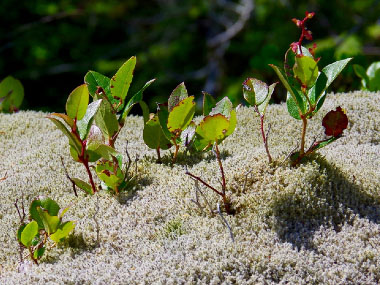
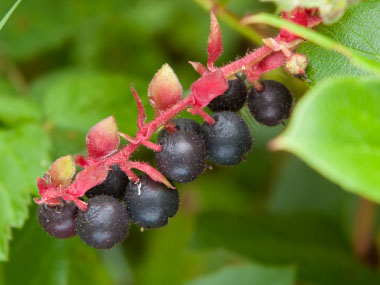
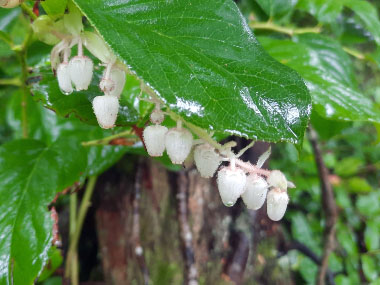
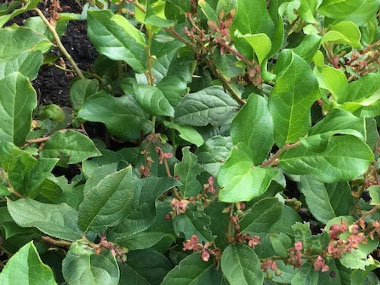
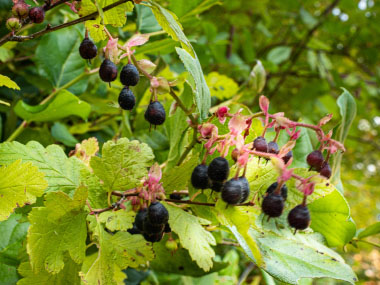
To support our efforts please browse our store (books with medicinal info, etc.).
Salal is a perennial, creeping or erect, evergreen shrub. Its genus name comes from a Canadian botanist and physician, Dr. Hugues Jean Gaulthier. Salal is in the heather (Ericaceae) family. Native to western North America, from Alaska to California, it is a common (coniferous) forest understory shrub. Salal is predominantly found at lower elevations due to its frost sensitivity. The leaves live 2 to 4 years and will grow at different times, so the shrub always has leaves. Stems and twigs live for 16 years or more. Most of the plant’s biomass is underground, and in many cases, the roots live for hundreds of years. It spreads by sprouting from underground stems. They tend to grow in an almost impenetrable thicket.
Trunk/Bark
Salal bark is rarely seen because of its thicket-forming nature. It bark is reddish brown to grayish brown and longitudinally scaly. Mature bark generally peels.
Branches/Twigs
Twigs are green to red and has short hairs. The twigs change angles between each node giving it a zig zag appearance. Older twigs are smooth and grayish brown. Twigs can live over 15 years, but bear leaves only the first few years.
Height
Salal is a slow growing shrub, but can grow to over 2 meters (6') tall in shady conditions. In sunny locations, it usually grows half as tall.
Leaves/Needles
Leaves are thick, dark green on top, and have a waxy feel to them. They are oval-shaped, measuring about 5 to 10cm (2 to 4") long and about to 3 to 7 cm (1 to 3") wide. They grow alternate.
Flowers
Flowers look like little white to pink bells (or urn shaped), are slightly sticky and they feel slightly hairy. Each flower is composed of a deeply five-parted, glandular-haired calyx, and a 5-lobed corolla that meaures 7 to 10 mm (0.27 to 0.39") long. Flowers bloom from May to July.
Fruit
Berries are a dull blue-black color when fully mature and are slightly hairy. They have a five-pointed star shape on the underside. Each fruit is about 1 cm rounded, and it ripens in summer.
Habitat
Salals grow in the understory of (mainly) coniferous forests, bogs, wet forests, and on rocky bluffs. Although they can be found somewhat inland, salals are usually found along the west coast of North America.
Edible Parts
Fruit is edible and has a slight sweetness to it. They were extensively used by many of the indigenous people of the Pacific northwest. In addition to eating the berries fresh, the indiginous people dried salals into cakes, to thicken salmon eggs and dipped in oolichan grease. The fruit can also be made into preserves, pies, juices, or they can be dried and used like raisins.
Other Name
Makah.
Recipes
Winter Survival Food Handbook

PDF Plant Magazines
Types of Wild Food
Geographic Zones Seasons
Disclaimer
EdibleWildFood.com is informational in nature. While we strive to be 100% accurate, it is solely up to the reader to ensure proper plant identification. Some wild plants are poisonous or can have serious adverse health effects.
We are not health professionals, medical doctors, nor are we nutritionists. It is up to the reader to verify nutritional information and health benefits with qualified professionals for all edible plants listed in this web site. Please click here for more information.
Why Edible Wild Food?
- Food costs are rising
- Free, wild food is readily abundant
- Wild food adds nutrition to your diet
- Wild food can help treat various medical conditions





